2D BP/InSe Heterostructures as a Nonlinear Optical Material for Ultrafast Photonics
Abstract
:1. Introduction
2. Preparation and Characterization
3. Nonlinear Optical Responses
| λ (nm) | (cm/GW) | Is (GW/cm2) | (%) | (%) |
|---|---|---|---|---|
| 800 | −0.11 | 9.86 | 16.82 | 15.74 |
| 1550 | −1.3 × 10−2 | 10.07 | 38.04 | 24.74 |
| λ (nm) | (cm/GW) | Is (GW/cm2) | References | |
|---|---|---|---|---|
| BP | 800 | −(0.68 ± 0.02) × 10−3 | 334.6 ± 43 | [44] |
| MoS2 | 800 | −(4.6 ± 0.27) × 10−3 | 413 ± 24 | [63] |
| MOFs | 800 | −3 × 10−2 | 30 | [64] |
| Ge | 800 | −(1.53 ± 0.31) × 10−4 | 16.4 ± 0.2 | [65] |
| Bi2Te3/FeTe2 | 800 | −7.53 × 10−4 | 314 | [66] |
| BP/Ti3C2 | 800 | -0.675 | 30.1 | [67] |
| BP/InSe | 800 | −0.11 | 9.86 | This work |
4. Ultrafast Photonics Application in Fiber Lasers
4.1. Typical Mode-Locked Pulse and 11th Harmonic Mode Locking of Bound State
4.2. Dark–Bright Soliton Pairs
5. Conclusions
Author Contributions
Funding
Institutional Review Board Statement
Informed Consent Statement
Data Availability Statement
Acknowledgments
Conflicts of Interest
References
- Jiang, T.; Yin, K.; Wang, C.; You, J.; Ouyang, H.; Miao, R.; Zhang, C.; Wei, K.; Li, H.; Chen, H. Ultrafast fiber lasers mode-locked by two-dimensional materials: Review and prospect. Photonics Res. 2020, 8, 78–90. [Google Scholar] [CrossRef]
- Yin, T.; Long, L.; Tang, X.; Qiu, M.; Liang, W.; Cao, R.; Zhang, Q.; Wang, D.; Zhang, H. Advancing Applications of Black Phosphorus and BP-Analog Materials in Photo/Electrocatalysis through Structure Engineering and Surface Modulation. Adv. Sci. 2020, 7, 2001431. [Google Scholar] [CrossRef]
- Zhang, J.; Chen, S.; Ma, Y.; Wang, D.; Zhang, J.; Wang, Y.; Li, W.; Yu, Z.; Zhang, H.; Yin, F. Organosilicon modification to enhance the stability of black phosphorus nanosheets under ambient conditions. J. Mater. Chem. B 2018, 6, 4065–4070. [Google Scholar] [CrossRef] [PubMed]
- Li, J.; Luo, H.; Zhai, B.; Lu, R.; Guo, Z.; Zhang, H.; Liu, Y. Black phosphorus: A two-dimension saturable absorption material for mid-infrared Q-switched and mode-locked fiber lasers. Sci. Rep. 2016, 6, 30361. [Google Scholar] [CrossRef] [PubMed] [Green Version]
- Tang, S.; He, Z.; Liang, G.; Chen, S.; Ge, Y.; Sang, D.K.; Lu, J.; Lu, S.; Wen, Q.; Zhang, H. Pulse duration dependent nonlinear optical response in black phosphorus dispersions. Opt. Commun. 2018, 406, 244–248. [Google Scholar] [CrossRef]
- Island, J.O.; Steele, G.A.; van der Zant, H.S.; Castellanos-Gomez, A. Environmental instability of few-layer black phosphorus. 2D Mater. 2015, 2, 011002. [Google Scholar] [CrossRef] [Green Version]
- Wan, B.; Yang, B.; Wang, Y.; Zhang, J.; Zeng, Z.; Liu, Z.; Wang, W. Enhanced stability of black phosphorus field-effect transistors with SiO2 passivation. Nanotechnology 2015, 26, 435702. [Google Scholar] [CrossRef]
- Hanlon, D.; Backes, C.; Doherty, E.; Cucinotta, C.S.; Berner, N.C.; Boland, C.; Lee, K.; Harvey, A.; Lynch, P.; Gholamvand, Z. Liquid exfoliation of solvent-stabilized few-layer black phosphorus for applications beyond electronics. Nat. Commun. 2015, 6, 8563. [Google Scholar] [CrossRef]
- Castellanos-Gomez, A.; Vicarelli, L.; Prada, E.; Island, J.O.; Narasimha-Acharya, K.; Blanter, S.I.; Groenendijk, D.J.; Buscema, M.; Steele, G.A.; Alvarez, J. Isolation and characterization of few-layer black phosphorus. 2D Mater. 2014, 1, 025001. [Google Scholar] [CrossRef]
- Wood, J.D.; Wells, S.A.; Jariwala, D.; Chen, K.-S.; Cho, E.; Sangwan, V.K.; Liu, X.; Lauhon, L.J.; Marks, T.J.; Hersam, M.C. Effective passivation of exfoliated black phosphorus transistors against ambient degradation. Nano Lett. 2014, 14, 6964–6970. [Google Scholar] [CrossRef] [Green Version]
- Jariwala, D.; Marks, T.J.; Hersam, M.C. Mixed-dimensional van der Waals heterostructures. Nat. Mater. 2017, 16, 170–181. [Google Scholar] [CrossRef] [PubMed]
- Gibertini, M.; Koperski, M.; Morpurgo, A.F.; Novoselov, K.S. Magnetic 2D materials and heterostructures. Nat. Nanotechnol. 2019, 14, 408–419. [Google Scholar] [CrossRef] [PubMed] [Green Version]
- Liu, Y.; Weiss, N.O.; Duan, X.; Cheng, H.-C.; Huang, Y.; Duan, X. Van der Waals heterostructures and devices. Nat. Rev. Mater. 2016, 1, 16042. [Google Scholar] [CrossRef]
- Novoselov, K.; Mishchenko, O.A.; Carvalho, O.A.; Neto, A.C. 2D materials and van der Waals heterostructures. Science 2016, 353, aac9439. [Google Scholar] [CrossRef] [PubMed] [Green Version]
- Geim, A.K.; Grigorieva, I.V. Van der Waals heterostructures. Nature 2013, 499, 419–425. [Google Scholar] [CrossRef]
- Niu, X.; Li, Y.; Zhang, Y.; Zheng, Q.; Zhao, J.; Wang, J. Highly efficient photogenerated electron transfer at a black phosphorus/indium selenide heterostructure interface from ultrafast dynamics. J. Mater. Chem. C 2019, 7, 1864–1870. [Google Scholar] [CrossRef]
- Han, X.; Han, J.; Liu, C.; Sun, J. Promise and challenge of phosphorus in science, technology, and application. Adv. Funct. Mater. 2018, 28, 1803471. [Google Scholar] [CrossRef]
- Lv, Q.; Yan, F.; Mori, N.; Zhu, W.; Hu, C.; Kudrynskyi, Z.R.; Kovalyuk, Z.D.; Patanè, A.; Wang, K. Interlayer Band-to-Band Tunneling and Negative Differential Resistance in van der Waals BP/InSe Field-Effect Transistors. Adv. Funct. Mater. 2020, 30, 1910713. [Google Scholar] [CrossRef] [Green Version]
- Ding, Y.-M.; Shi, J.-J.; Xia, C.; Zhang, M.; Du, J.; Huang, P.; Wu, M.; Wang, H.; Cen, Y.-L.; Pan, S.-H. Enhancement of hole mobility in InSe monolayer via an InSe and black phosphorus heterostructure. Nanoscale 2017, 9, 14682–14689. [Google Scholar] [CrossRef]
- Gao, A.; Lai, J.; Wang, Y.; Zhu, Z.; Zeng, J.; Yu, G.; Wang, N.; Chen, W.; Cao, T.; Hu, W. Observation of ballistic avalanche phenomena in nanoscale vertical InSe/BP heterostructures. Nat. Nanotechnol. 2019, 14, 217–222. [Google Scholar] [CrossRef] [Green Version]
- Cao, R.; Wang, H.D.; Guo, Z.N.; Sang, D.K.; Zhang, L.Y.; Xiao, Q.L.; Zhang, Y.P.; Fan, D.Y.; Li, J.Q.; Zhang, H. Black phosphorous/indium selenide photoconductive detector for visible and near-infrared light with high sensitivity. Adv. Opt. Mater. 2019, 7, 1900020. [Google Scholar] [CrossRef]
- Mas-Balleste, R.; Gomez-Navarro, C.; Gomez-Herrero, J.; Zamora, F. 2D materials: To graphene and beyond. Nanoscale 2011, 3, 20–30. [Google Scholar] [CrossRef] [PubMed]
- Zhou, F.; Chen, J.; Tao, X.; Wang, X.; Chai, Y. 2D materials based optoelectronic memory: Convergence of electronic memory and optical sensor. Research 2019, 2019, 9490413. [Google Scholar] [CrossRef] [Green Version]
- You, J.W.; Bongu, S.R.; Bao, Q.; Panoiu, N.C. Nonlinear optical properties and applications of 2D materials: Theoretical and experimental aspects. Nanophotonics 2018, 8, 63–97. [Google Scholar] [CrossRef]
- Li, Q.; Lu, J.; Gupta, P.; Qiu, M. Engineering Optical Absorption in Graphene and Other 2D Materials: Advances and Applications. Adv. Opt. Mater. 2019, 7, 1900595. [Google Scholar] [CrossRef]
- Yu, S.; Wu, X.; Wang, Y.; Guo, X.; Tong, L. 2D materials for optical modulation: Challenges and opportunities. Adv. Mater. 2017, 29, 1606128. [Google Scholar] [CrossRef]
- Hall, J.L.; Ye, J.; Diddams, S.A.; Ma, L.-S.; Cundiff, S.T.; Jones, D.J. Ultrasensitive spectroscopy, the ultrastable lasers, the ultrafast lasers, and the seriously nonlinear fiber: A new alliance for physics and metrology. IEEE J. Quantum Electron. 2001, 37, 1482–1492. [Google Scholar] [CrossRef] [Green Version]
- Herman, P.; Marjoribanks, R.; Oettl, A.; Chen, K.; Konovalov, I.; Ness, S. Laser shaping of photonic materials: Deep-ultraviolet and ultrafast lasers. Appl. Surf. Sci. 2000, 154, 577–586. [Google Scholar] [CrossRef]
- Backus, S.; Durfee, C.G.; Murnane, M.M.; Kapteyn, H.C. High power ultrafast lasers. Rev. Sci. Instrum. 1998, 69, 1207. [Google Scholar] [CrossRef]
- Sugioka, K.; Cheng, Y. Ultrafast lasers—Reliable tools for advanced materials processing. Light Sci. Appl. 2014, 3, e149. [Google Scholar] [CrossRef]
- Keller, U. Recent developments in compact ultrafast lasers. Nature 2003, 424, 831–838. [Google Scholar] [CrossRef]
- Zhu, X.; Peyghambarian, N. High-power ZBLAN glass fiber lasers: Review and prospect. Adv. Optoelectron. 2010, 2010, 501956. [Google Scholar] [CrossRef] [Green Version]
- Richardson, D.J.; Nilsson, J.; Clarkson, W.A. High power fiber lasers: Current status and future perspectives. JOSA B 2010, 27, B63–B92. [Google Scholar] [CrossRef]
- Zervas, M.N.; Codemard, C.A. High power fiber lasers: A review. IEEE J. Sel. Top. Quantum Electron. 2014, 20, 219–241. [Google Scholar] [CrossRef]
- Jiang, Y.; Liu, Y.; Liu, X.; Lin, H.; Huang, W. Organic solid-state lasers: A materials view and future development. Chem. Soc. Rev. 2020, 49, 5885–5944. [Google Scholar] [CrossRef]
- Krupke, W.F. Ytterbium solid-state lasers. The first decade. IEEE J. Sel. Top. Quantum Electron. 2000, 6, 1287–1296. [Google Scholar] [CrossRef]
- Fan, T.Y.; Byer, R.L. Diode laser-pumped solid-state lasers. IEEE J. Quantum Electron. 1988, 24, 895–912. [Google Scholar] [CrossRef] [Green Version]
- Yao, Y.; Hoffman, A.J.; Gmachl, C.F. Mid-infrared quantum cascade lasers. Nat. Photonics 2012, 6, 432–439. [Google Scholar] [CrossRef]
- Vitiello, M.S.; Scalari, G.; Williams, B.; De Natale, P. Quantum cascade lasers: 20 years of challenges. Opt. Express 2015, 23, 5167–5182. [Google Scholar] [CrossRef]
- Gmachl, C.; Capasso, F.; Sivco, D.L.; Cho, A.Y. Recent progress in quantum cascade lasers and applications. Rep. Prog. Phys. 2001, 64, 1533. [Google Scholar] [CrossRef]
- Cheung, E.; Koch, K.; Moore, G.T. Frequency upconversion by phase-matched sum-frequency generation in an optical parametric oscillator. Opt. Lett. 1994, 19, 1967–1969. [Google Scholar] [CrossRef] [PubMed]
- Raghunathan, V.; Han, Y.; Korth, O.; Ge, N.H.; Potma, E.O. Rapid vibrational imaging with sum frequency generation microscopy. Opt. Lett. 2011, 36, 3891–3893. [Google Scholar] [CrossRef] [PubMed] [Green Version]
- Shu, Y.; Guo, J.; Fan, T.; Xu, Y.; Guo, P.; Wang, Z.; Wu, L.; Ge, Y.; Lin, Z.; Ma, D. Two-dimensional black arsenic phosphorus for ultrafast photonics in near-and mid-infrared regimes. ACS Appl. Mater. Interfaces 2020, 12, 46509–46518. [Google Scholar] [CrossRef] [PubMed]
- Guo, J.; Zhang, Y.; Wang, Z.; Shu, Y.; He, Z.; Zhang, F.; Gao, L.; Li, C.; Wang, C.; Song, Y. Tellurium@ Selenium core-shell hetero-junction: Facile synthesis, nonlinear optics, and ultrafast photonics applications towards mid-infrared regime. Appl. Mater. Today 2020, 20, 100657. [Google Scholar] [CrossRef]
- Shu, Y.; Guo, P.; Li, X.; Li, G.; Wang, P.; Shen, G.; Li, J. Gold nanorods as saturable absorber for harmonic soliton molecules generation. Front. Chem. 2019, 2019, 715. [Google Scholar] [CrossRef] [PubMed]
- Kurtner, F.X.; Der Au, J.A.; Keller, U. Mode-locking with slow and fast saturable absorbers-what’s the difference? IEEE J. Sel. Top. Quantum Electron. 1998, 4, 159–168. [Google Scholar] [CrossRef] [Green Version]
- Luo, Z.; Wu, D.; Xu, B.; Xu, H.; Cai, Z.; Peng, J.; Weng, J.; Xu, S.; Zhu, C.; Wang, F. Two-dimensional material-based saturable absorbers: Towards compact visible-wavelength all-fiber pulsed lasers. Nanoscale 2016, 8, 1066–1072. [Google Scholar] [CrossRef] [Green Version]
- Yamashita, S.; Inoue, Y.; Maruyama, S.; Murakami, Y.; Yaguchi, H.; Jablonski, M.; Set, S. Saturable absorbers incorporating carbon nanotubes directly synthesized onto substrates and fibers and their application to mode-locked fiber lasers. Opt. Lett. 2004, 29, 1581–1583. [Google Scholar] [CrossRef]
- Zhang, M.; Wu, Q.; Zhang, F.; Chen, L.; Jin, X.; Hu, Y.; Zheng, Z.; Zhang, H. 2D Black Phosphorus Saturable Absorbers for Ultrafast Photonics. Adv. Opt. Mater. 2019, 7, 1800224. [Google Scholar] [CrossRef] [Green Version]
- Ma, C.; Wang, C.; Gao, B.; Adams, J.; Wu, G.; Zhang, H. Recent progress in ultrafast lasers based on 2D materials as a saturable absorber. Appl. Phys. Rev. 2019, 6, 041304. [Google Scholar] [CrossRef]
- Bourlinos, A.B.; Georgakilas, V.; Zboril, R.; Steriotis, T.A.; Stubos, A.K. Liquid-phase exfoliation of graphite towards solubilized graphenes. Small 2009, 5, 1841–1845. [Google Scholar] [CrossRef] [PubMed]
- Hernandez, Y.; Nicolosi, V.; Lotya, M.; Blighe, F.M.; Sun, Z.; De, S.; McGovern, I.; Holland, B.; Byrne, M.; Gun’Ko, Y.K. High-yield production of graphene by liquid-phase exfoliation of graphite. Nat. Nanotechnol. 2008, 3, 563–568. [Google Scholar] [CrossRef] [PubMed] [Green Version]
- Yan, B.; Li, G.; Shi, B.; Liu, J.; Nie, H.; Yang, K.; Zhang, B.; He, J. 2D tellurene/black phosphorus heterojunctions based broadband nonlinear saturable absorber. Nanophotonics 2020, 9, 2593–2602. [Google Scholar] [CrossRef]
- Jiang, T.; Yin, K.; Zheng, X.; Yu, H.; Cheng, X.-A. Black phosphorus as a new broadband saturable absorber for infrared passively Q-switched fiber lasers. arXiv 2015, arXiv:1504.07341. [Google Scholar] [CrossRef]
- Li, Z.; Qiao, H.; Guo, Z.; Ren, X.; Huang, Z.; Qi, X.; Dhanabalan, S.C.; Ponraj, J.S.; Zhang, D.; Li, J. High-performance photo-electrochemical photodetector based on liquid-exfoliated few-layered InSe nanosheets with enhanced stability. Adv. Funct. Mater. 2018, 28, 1705237. [Google Scholar] [CrossRef]
- Browning, R.; Kuperman, N.; Moon, B.; Solanki, R. Atomic layer growth of InSe and Sb2Se3 layered semiconductors and their heterostructure. Electronics 2017, 6, 27. [Google Scholar] [CrossRef]
- Ge, Y.; Chen, S.; Xu, Y.; He, Z.; Liang, Z.; Chen, Y.; Song, Y.; Fan, D.; Zhang, K.; Zhang, H. Few-layer selenium-doped black phosphorus: Synthesis, nonlinear optical properties and ultrafast photonics applications. J. Mater. Chem. C 2017, 5, 6129–6135. [Google Scholar] [CrossRef]
- Chambers, S.A.; Wang, L.; Baer, D.R. Introductory guide to the application of XPS to epitaxial films and heterostructures. J. Vac. Sci. Technol. A Vac. Surf. Film. 2020, 38, 061201. [Google Scholar] [CrossRef]
- Chapple, P.; Staromlynska, J.; Hermann, J.; Mckay, T.; McDuff, R. Single-beam Z-scan: Measurement techniques and analysis. J. Nonlinear Opt. Phys. Mater. 1997, 6, 251–293. [Google Scholar] [CrossRef]
- Wang, J.; Sheik-Bahae, M.; Said, A.; Hagan, D.J.; Van Stryland, E.W. Time-resolved Z-scan measurements of optical nonlinearities. JOSA B 1994, 11, 1009–1017. [Google Scholar] [CrossRef] [Green Version]
- Gu, B.; Fan, Y.-X.; Chen, J.; Wang, H.-T.; He, J.; Ji, W. Z-scan theory of two-photon absorption saturation and experimental evidence. J. Appl. Phys. 2007, 102, 083101. [Google Scholar] [CrossRef]
- Sheikbahae, M.; Said, A.A.; Wei, T.H.; Hagan, D.J.; Vanstryland, E.W. Sensitive Measurement of Optical Nonlinearities Using a Single Beam. IEEE J. Quantum Electron. 1990, 26, 760–769. [Google Scholar] [CrossRef] [Green Version]
- Wang, K.; Feng, Y.; Chang, C.; Zhan, J.; Wang, C.; Zhao, Q.; Coleman, J.N.; Zhang, L.; Blau, W.J.; Wang, J. Broadband ultrafast nonlinear absorption and nonlinear refraction of layered molybdenum dichalcogenide semiconductors. Nanoscale 2014, 6, 10530–10535. [Google Scholar] [CrossRef] [PubMed] [Green Version]
- Jiang, X.; Zhang, L.; Liu, S.; Zhang, Y.; He, Z.; Li, W.; Zhang, F.; Shi, Y.; Lü, W.; Li, Y. Ultrathin metal–organic framework: An emerging broadband nonlinear optical material for ultrafast photonics. Adv. Opt. Mater. 2018, 6, 1800561. [Google Scholar] [CrossRef]
- Mu, H.; Liu, Y.; Bongu, S.R.; Bao, X.; Li, L.; Xiao, S.; Zhuang, J.; Liu, C.; Huang, Y.; Dong, Y.; et al. Germanium Nanosheets with Dirac Characteristics as a Saturable Absorber for Ultrafast Pulse Generation. Adv. Mater. 2021, 33, 2101042. [Google Scholar] [CrossRef]
- Zhang, L.; Liu, J.; Li, J.; Wang, Z.; Wang, Y.; Ge, Y.; Dong, W.; Xu, N.; He, T.; Zhang, H.; et al. Site-Selective Bi2Te3–FeTe2 Heterostructure as a Broadband Saturable Absorber for Ultrafast Photonics. Laser Photonics Rev. 2020, 14, 1900409. [Google Scholar] [CrossRef]
- Xia, X.F.; Ma, C.Y.; Chen, H.L.; Khan, K.; Tateen, A.K.; Xiao, Q.L. Nonlinear optical properties and ultrafast photonics of 2D BP/Ti3C2 heterostructures. Opt. Mater. 2021, 112, 110809. [Google Scholar] [CrossRef]
- Pawliszewska, M.; Ge, Y.; Li, Z.; Zhang, H.; Sotor, J. Fundamental and harmonic mode-locking at 2.1 μm with black phosphorus saturable absorber. Opt. Express 2017, 25, 16916–16921. [Google Scholar] [CrossRef]
- Harun, S.W.; Saidin, N.; Zen, D.; Ali, N.; Ahmad, H.; Ahmad, F.; Dimyati, K. Self-starting harmonic mode-locked thulium-doped fiber laser with carbon nanotubes saturable absorber. Chin. Phys. Lett. 2013, 30, 094204. [Google Scholar] [CrossRef] [Green Version]
- Wang, Z.; Zhan, L.; Majeed, A.; Zou, Z. Harmonic mode locking of bound solitons. Opt. Lett. 2015, 40, 1065–1068. [Google Scholar] [CrossRef]
- Guo, J.; Hu, X.; Ma, J.; Zhao, L.; Shen, D.; Tang, D. Anti-dark solitons in a single mode fiber laser. Phys. Lett. A 2021, 395, 127226. [Google Scholar] [CrossRef]
- Song, Y.; Shi, X.; Wu, C.; Tang, D.; Zhang, H. Recent progress of study on optical solitons in fiber lasers. Appl. Phys. Rev. 2019, 6, 021313. [Google Scholar] [CrossRef]
- Tang, Y.; Chong, A.; Wise, F.W. Generation of 8 nJ pulses from a normal-dispersion thulium fiber laser. Opt. Lett. 2015, 40, 2361–2364. [Google Scholar] [CrossRef] [PubMed]
- Zheng, Y.; Wang, M.; Zhao, R.; Zhang, H.; Liu, D.; Li, D. Nonlinear optical absorption properties of zirconium selenide in generating dark soliton and dark-bright soliton pairs. Appl. Opt. 2020, 59, 396–404. [Google Scholar] [CrossRef]
- Yin, H.; Xu, W.; Luo, A.-P.; Luo, Z.-C.; Liu, J. Observation of dark pulse in a dispersion-managed fiber ring laser. Opt. Commun. 2010, 283, 4338–4341. [Google Scholar] [CrossRef]
- Wang, P.; Zhao, K.; Xiao, X.; Yang, C. Pulse dynamics of dual-wavelength dissipative soliton resonances and domain wall solitons in a Tm fiber laser with fiber-based Lyot filter. Opt. Express 2017, 25, 30708–30719. [Google Scholar] [CrossRef] [PubMed]
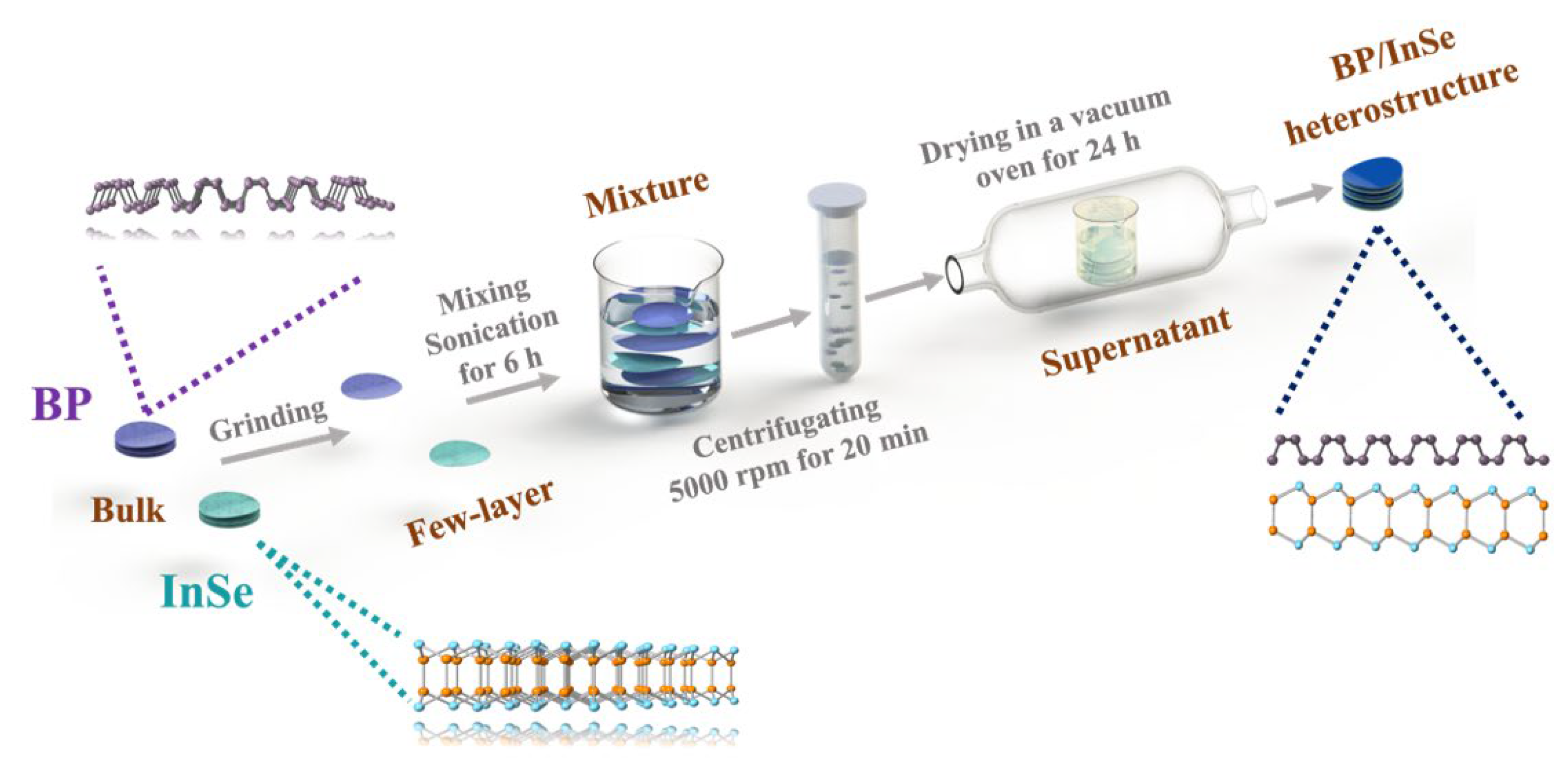
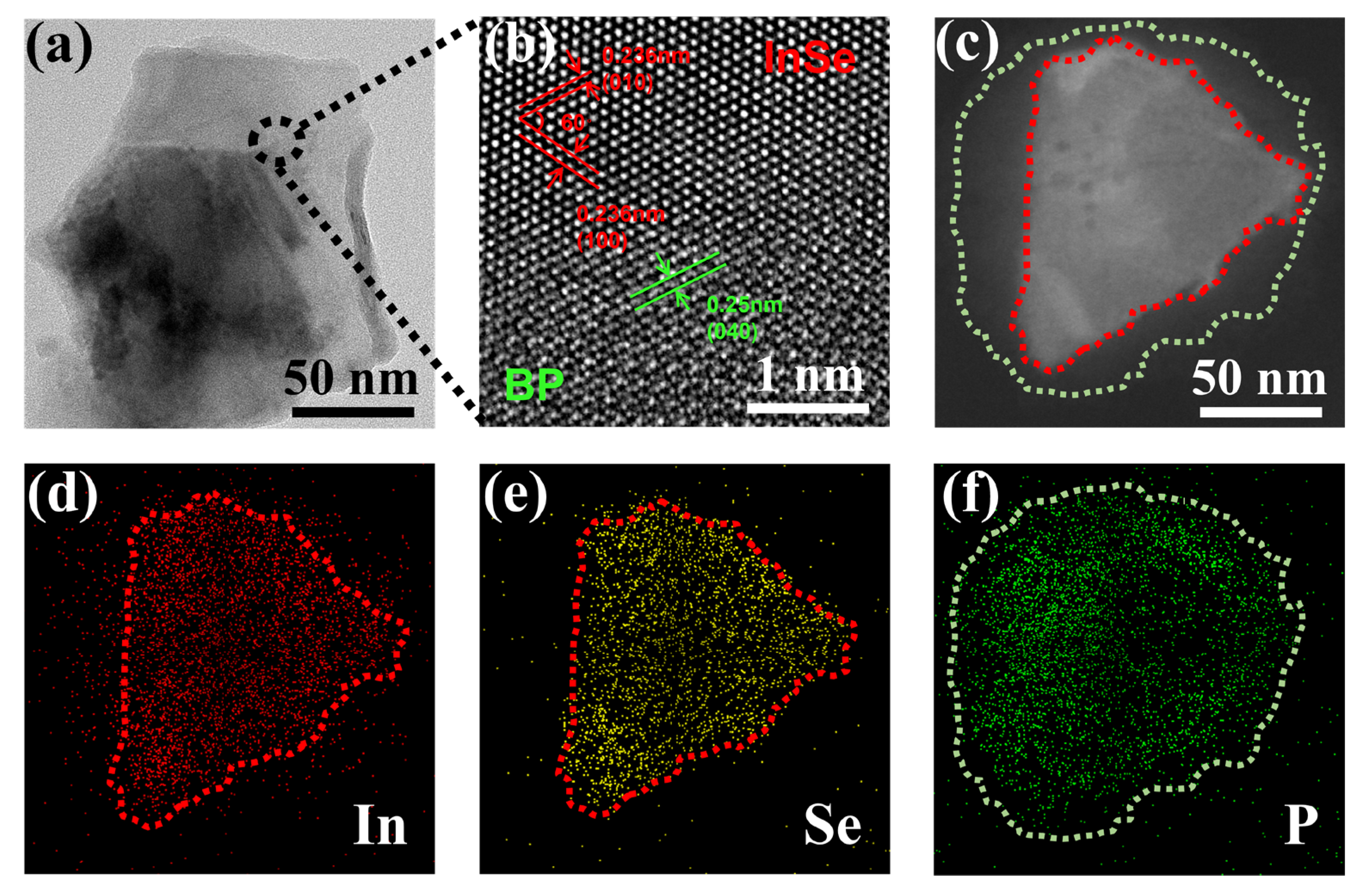

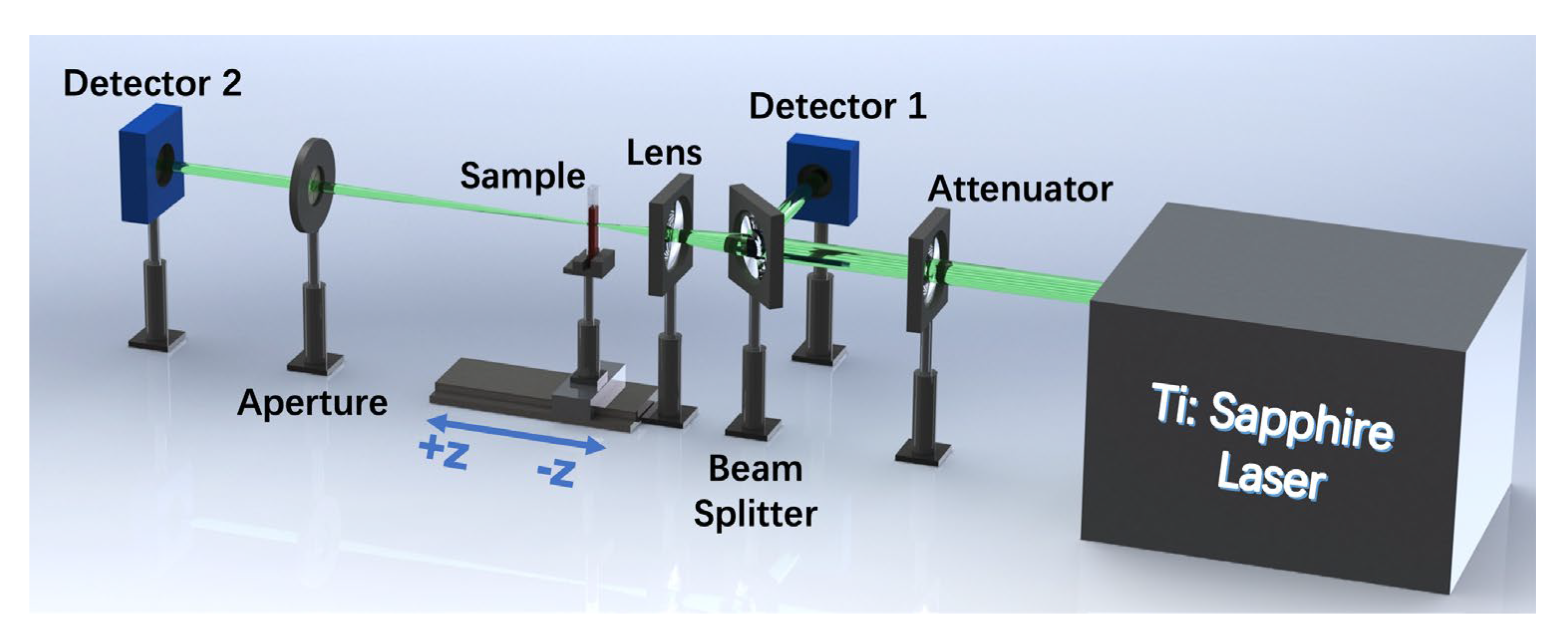
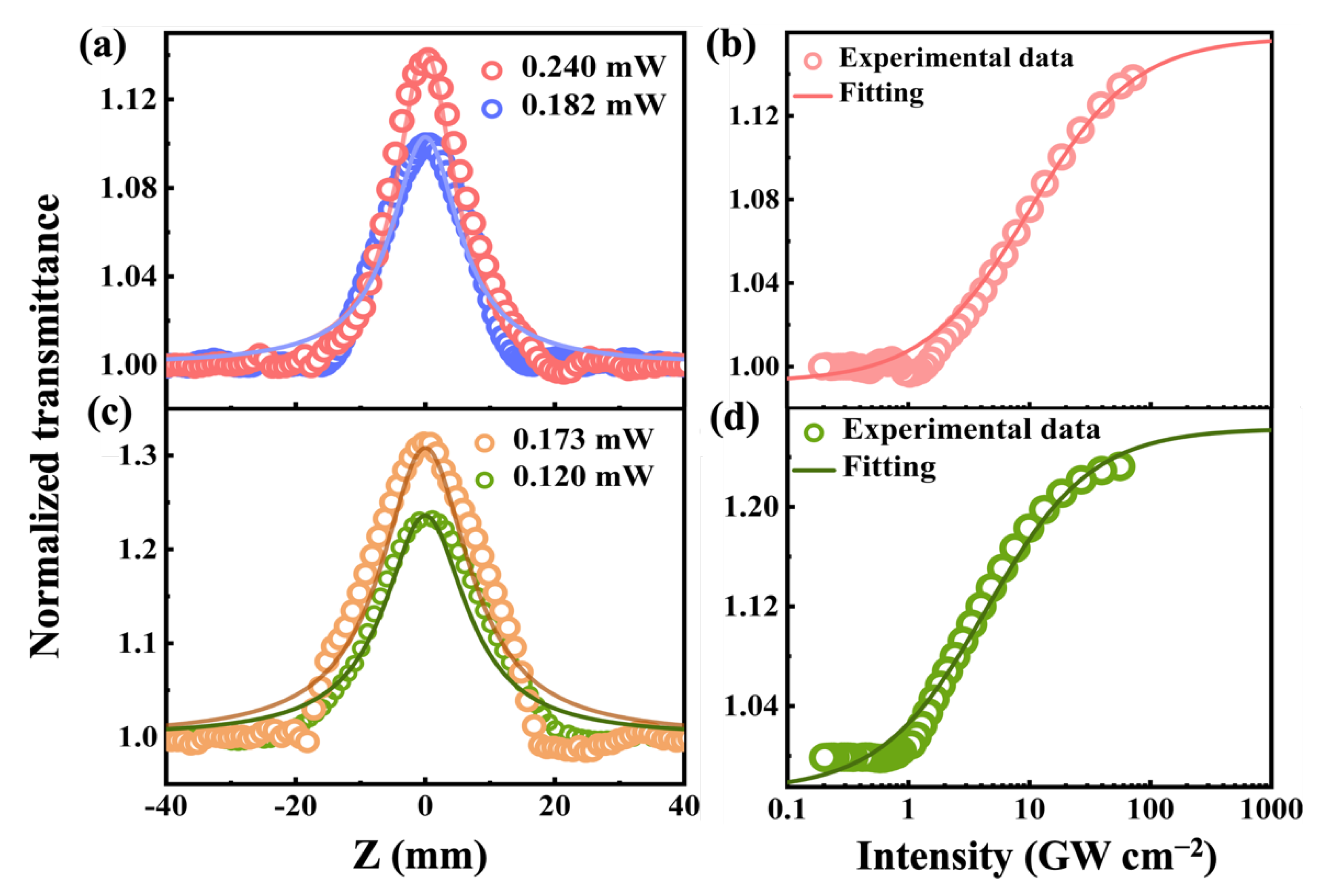
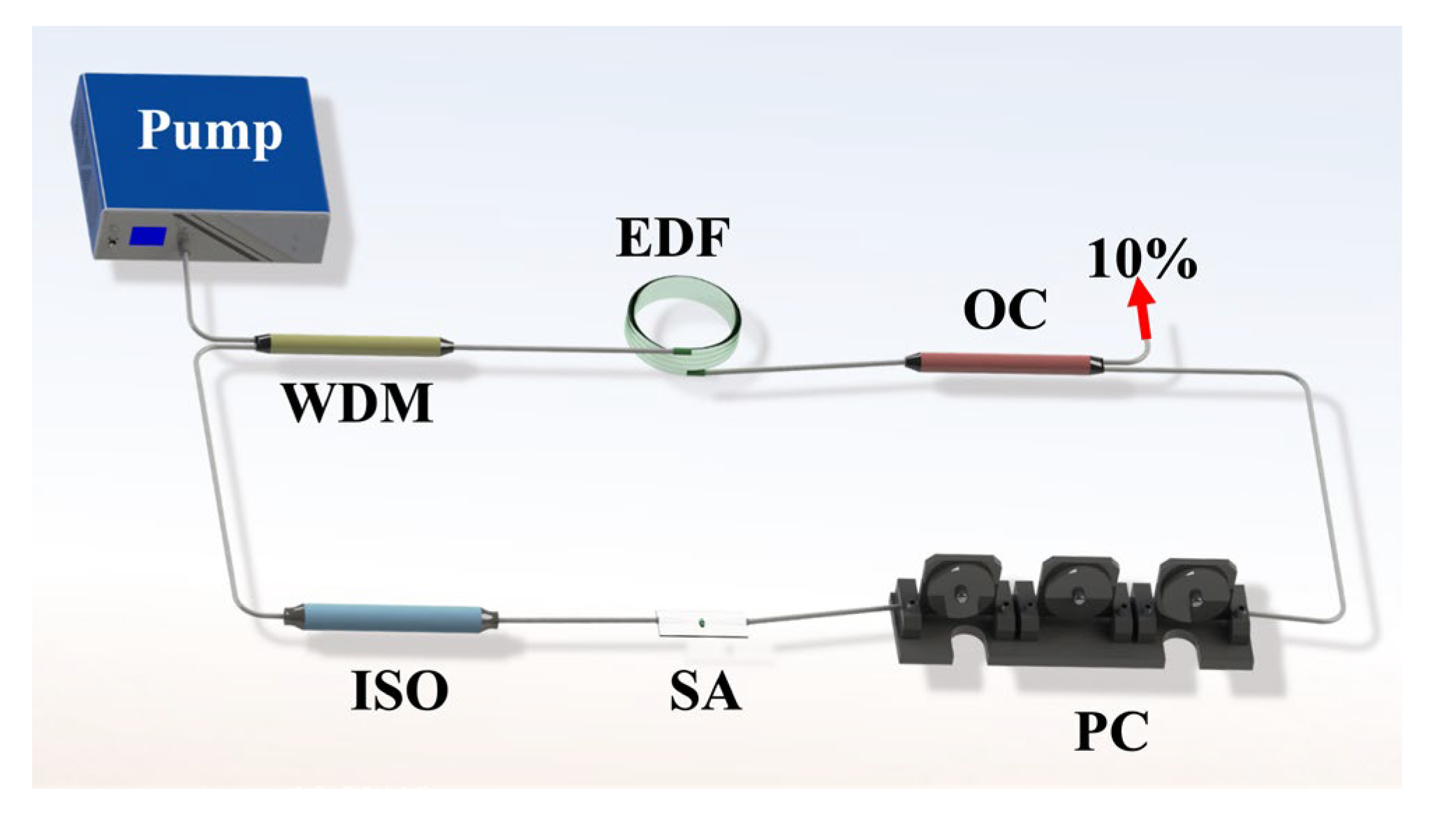
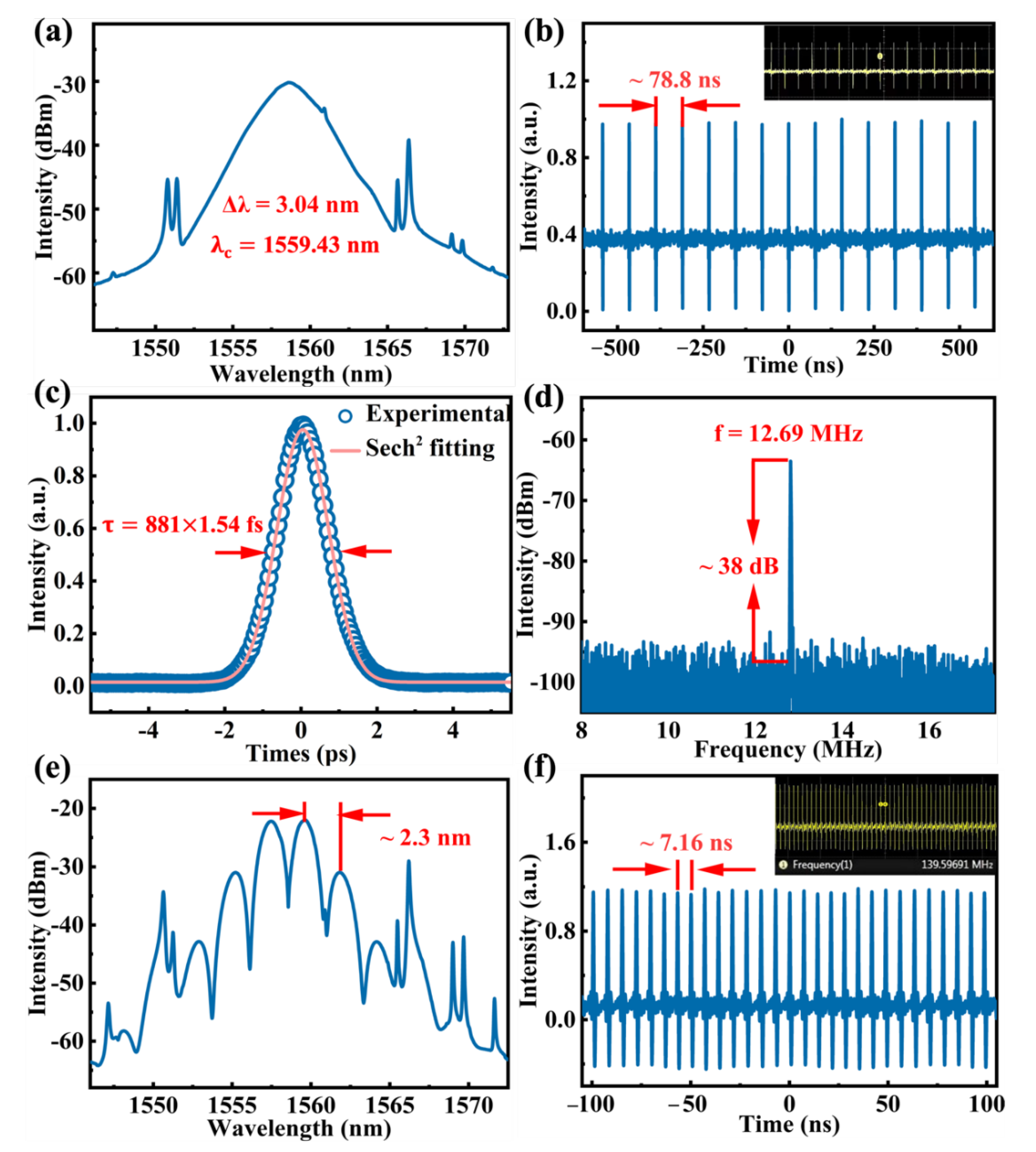
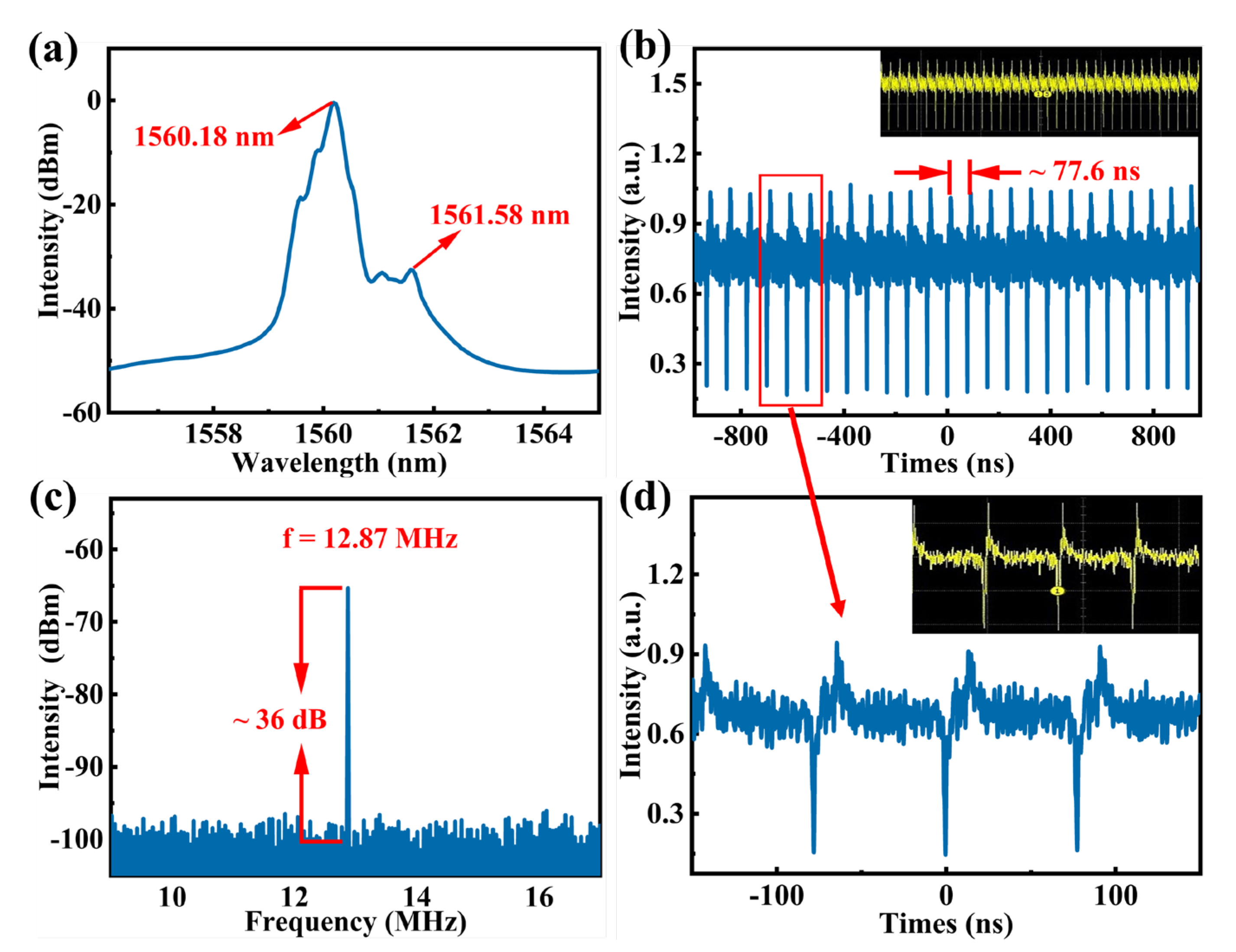
Publisher’s Note: MDPI stays neutral with regard to jurisdictional claims in published maps and institutional affiliations. |
© 2022 by the authors. Licensee MDPI, Basel, Switzerland. This article is an open access article distributed under the terms and conditions of the Creative Commons Attribution (CC BY) license (https://creativecommons.org/licenses/by/4.0/).
Share and Cite
Shu, Y.; Zhong, Z.; Ma, C.; Guo, P.; Wu, L.; Lin, Z.; Yuan, X.; Li, J.; Chen, W.; Xiao, Q. 2D BP/InSe Heterostructures as a Nonlinear Optical Material for Ultrafast Photonics. Nanomaterials 2022, 12, 1809. https://doi.org/10.3390/nano12111809
Shu Y, Zhong Z, Ma C, Guo P, Wu L, Lin Z, Yuan X, Li J, Chen W, Xiao Q. 2D BP/InSe Heterostructures as a Nonlinear Optical Material for Ultrafast Photonics. Nanomaterials. 2022; 12(11):1809. https://doi.org/10.3390/nano12111809
Chicago/Turabian StyleShu, Yiqing, Zijun Zhong, Chunyang Ma, Penglai Guo, Leiming Wu, Zhitao Lin, Xun Yuan, Jianqing Li, Weicheng Chen, and Quanlan Xiao. 2022. "2D BP/InSe Heterostructures as a Nonlinear Optical Material for Ultrafast Photonics" Nanomaterials 12, no. 11: 1809. https://doi.org/10.3390/nano12111809
APA StyleShu, Y., Zhong, Z., Ma, C., Guo, P., Wu, L., Lin, Z., Yuan, X., Li, J., Chen, W., & Xiao, Q. (2022). 2D BP/InSe Heterostructures as a Nonlinear Optical Material for Ultrafast Photonics. Nanomaterials, 12(11), 1809. https://doi.org/10.3390/nano12111809







